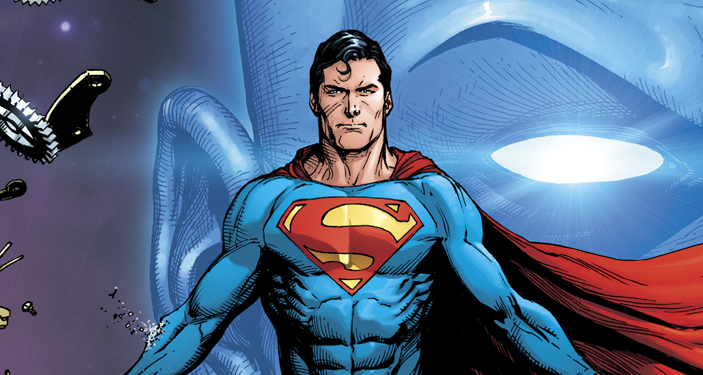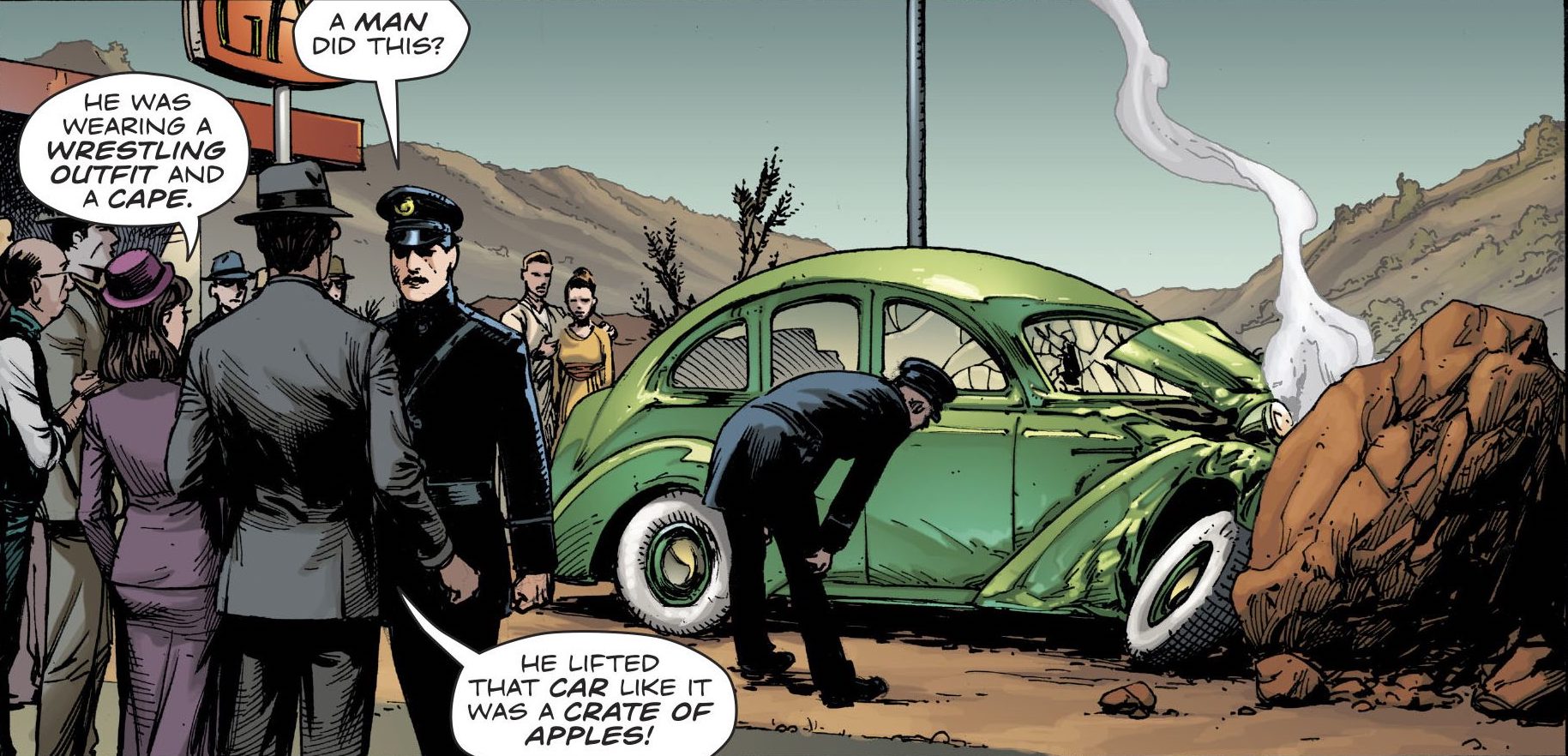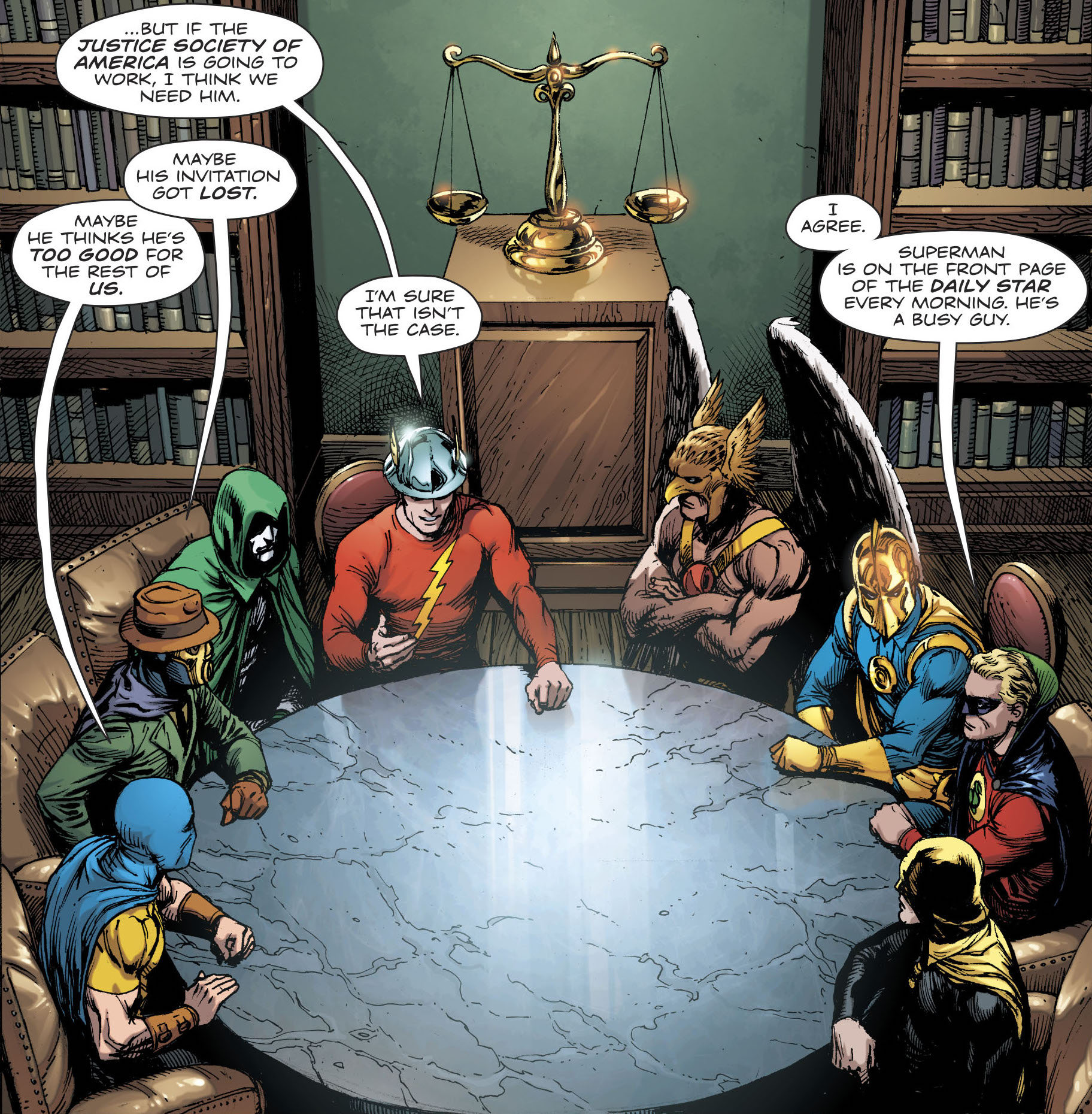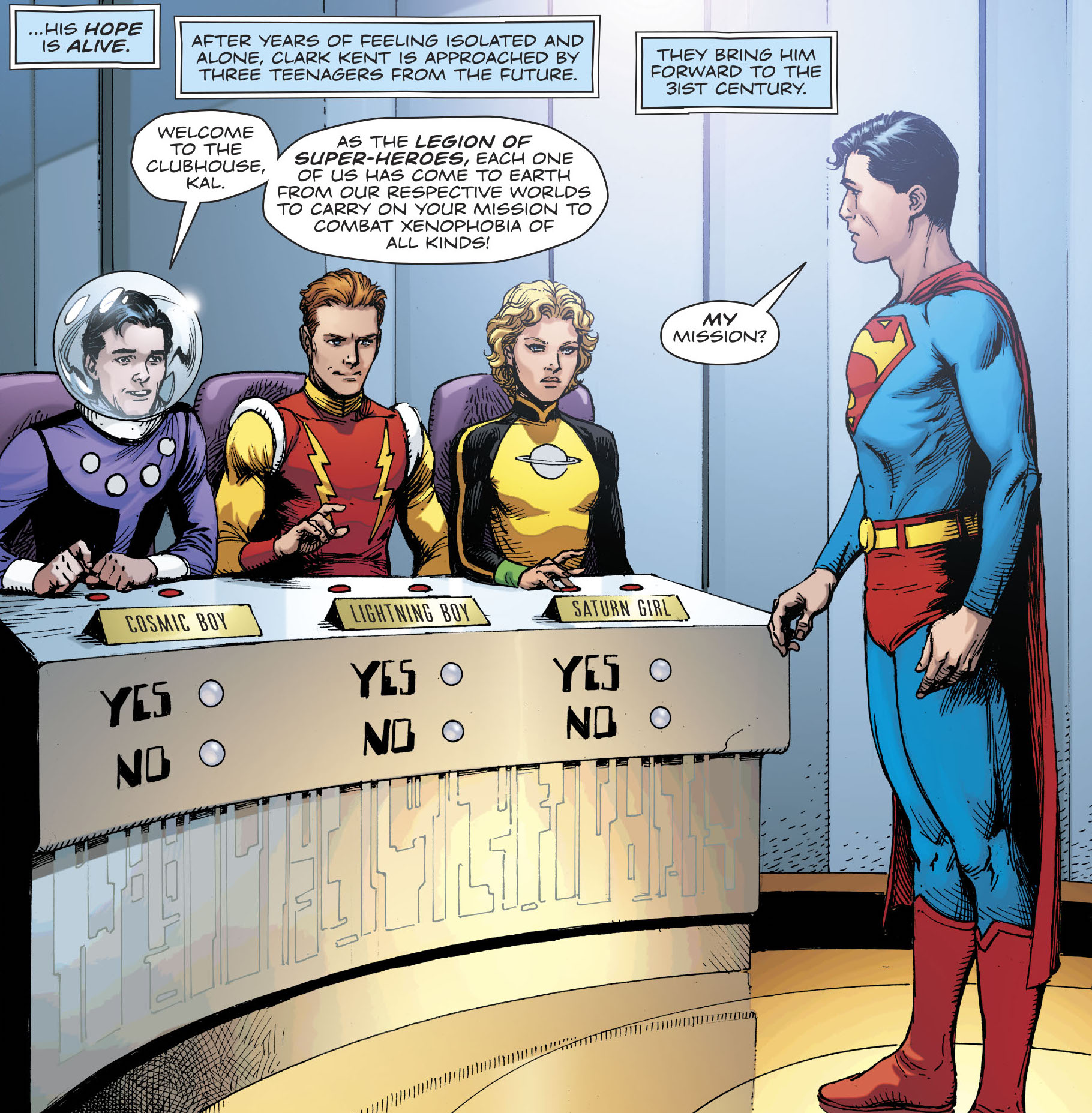Amid all the controversy, Johns and Frank deliver for fans of the Golden, Silver and Bronze Ages…

Comics fans are a notoriously difficult breed to please, particularly if you’re of a particular vintage.
I myself grew up in the Bronze Age and spent a ton of time diving into the Silver and Golden Ages. I loved it all. It was just a matter of degrees. But unlike a lot of my contemporaries, I’m not put off by what the major publishers have produced over, say, the last 25-30 years or so.
I love some of it, like some of it and dislike some of it. I read what I like and don’t read what I don’t like. Do today’s comics speak to me like they did when I was 12? No. But that’s also because I’m not 12 anymore.
My point — and you almost certainly know this if you read 13th Dimension with any regularity – is that I’m generally a big-tent kind of guy when it comes to comics.
Not the case for many of my contemporaries, who on principle dislike intensely what DC and Marvel produce nowadays.
But there’s an elixir sitting on comics store shelves right now that should go a long way toward providing some relief to those disgruntled fans of the Golden, Silver and Bronze Ages – and it’s Doomsday Clock #10, by Geoff Johns, Gary Frank and Brad Anderson.

Frank’s variant cover
Yeah, I know. A lot of you are completely put off by the mere notion of a series that’s a direct sequel to Watchmen – let alone one that combines that universe with the primary DC Universe.
But here’s the thing: Issue #10 does something that no comic has been able to since Crisis on Infinite Earths – explain how all iterations of the DC Universe connect to one another, going way back to Action Comics #1.
It’s not the Multiverse. It’s not Hypertime. It’s called the Metaverse.
Now, I strongly recommend you pick up a copy of the issue, which is marvelously entertaining in its own right, with gorgeous art and compelling storytelling. There are satisfying appearances of the original Justice Society of America and Legion of Super-Heroes – and I actually think you could read the issue even if you haven’t been following the series.
Because in addition to seeing those classic characters, we’re walked through Johns’ inventive notion of how the DC Universe actually works – and what it means for longtime fans.
In a nutshell, Dr. Manhattan discovers that in the prime DCU, Superman actually did arrive on Earth in 1938, auguring what we call the Golden Age. Then, history was changed and a new reality was born where he first appeared in 1956, heralding the Silver Age. Then, it happened again in 1986 and so on.

The cover of Action Comics #1 — minutes later, as depicted in Doomsday Clock #10.
Each time history was changed – with Superman as the fulcrum — the Multiverse was changed with it, expanding and contracting along the way.
But all those stories happened. All those worlds existed – and continue to do so, in a fashion.
Writer Geoff Johns lays it all at the feet of Bryce DeWitt, the late, real-life theoretical physicist, who, as Dr. Manhattan explains, “hypothesized that the universe was constantly splitting into alternate timelines. The many worlds interpretation. It theorized that parallel worlds were endlessly created, flowing out like the branches of a tree.”
Johns, again through Dr. Manhattan, later adds, “The Multiverse reacts to this universe. There have been endless parallel worlds, none, fifty-two, dark multiverses, all created by changes to this universe.
“This universe stands apart from the Multiverse. It is the Metaverse. And it is in a constant state of change.”

The JSA meets in Doomsday Clock #10.
Dr. Manhattan says that the changes were wrought by the Anti-Monitor (a Crisis reference), Extant (Zero Hour) and himself. But really, those characters are stand-ins for editors, writers and artists who for 80-plus years have been monkeying with the direction of what became the DCU.
Fittingly, Dr. Manhattan is also an avatar for fandom: He’s able to shift through time periods and realities on a whim. So can we. He can do it through quantum physics. We can do it by reading back issues.
How very meta. Hence, the Metaverse.
(Side note: If there’s a weakness in the concept, it’s that Superman is at the center of all of it. That’s true in large measure, obviously, but it’s the Barry Allen Flash who drove the launch of the Silver Age. Johns certainly knows that but he seems to be taking license, unless he chooses to delve into that in the series’ final two issues. Either way, he’s not wrong: Superman is DC’s – and comicdom’s — Big Bang.)

Doomsday Clock #10’s take on Superboy’s first meeting with the Legion.
In any event, it’s a brilliant way of infusing the realities of publishing and fandom with DC’s fictional constructs – paradoxes and all. It’s neat and messy and complex and simple all at once.
Most of all, the Metaverse is an acknowledgment – a celebration even – of all that’s come before and all that’s still to come.
Because the bottom line is that what we love about DC Comics has always been here. It is here now and it will always be here.
—
MORE
— Why It’s OK That WATCHMEN and the DC Universe Will Collide. Click here.
— Dave Gibbons Talks WATCHMEN vs. DARK KNIGHT RETURNS. Click here.

June 1, 2019
Downloaded this ish because of this review. Loved it. Wish the digital had that variant JSA cover tho. Thanks for always posting such great content.
June 2, 2019
Glad to be of service!
June 1, 2019
But it doesn’t really change anything. Saying that Superman is at the center of all the variant parallel universes really doesn’t work to explain EVERYTHING, because… there are parallel universes within the DC multiverse where Superman (or one of his doppleganger counterparts) just doesn’t exist, and NEVER existed. What about the anti-matter universe of Qward, the Crime Syndicate universe of Earth-3, or something like Gemworld? No Kal-El in any of those, or at least no Supeman on Earth (Ultraman of Earth-3 is NOT a true multiversal counterpart of Superman; he’s NOT, and never was, Kal-El of Krypton). No, you still have to go back to the CRISIS ON INFINITE EARTHS explanation of the Maltusian Krona’s meddling in trying to discover the origin of the original universe. That happened eons and eons of time before Kal-El came into existence, and created the DC multiverse. The beauty of that creation myth is that Krona, for the DC multiverse, becomes like Pandora of Greek myth, or the serpent in the Garden of Eden, unleashing Knowledge of Good and Evil into a Golden Age universe of utopian bliss, creating multiverses where evil (and thus drama and conflict) now exists to drive new mythological stories.
I mean, it’s a nice thought — that SUPERMAN is central to everything on every plane of existence of the multiverse — it simply *doesn’t work* to explain EVERYTHING. No number of DC reboots wipes that story out, because Dr. Manhattan is already referring to the prior existence of pre-rebooted characters like the Anti-Montor and Extant. CRISIS still happened; ZERO HOUR still happened; and those events supersede and pre-date any changes that Superman’s existence (or lack thereof, in any time period) would have wrought in spinning off new parallel timelines. But nice try, anyway.
June 1, 2019
For that matter, Superman’s arrival on Earth (or failure to arrive on Earth at any particular time) doesn’t explain anything about how the universe of WATCHMEN comes into existence…
June 1, 2019
What I mean is, DOOMSDAY CLOCK #10 isn’t even internally consistent in its explanation. If I read the story correctly, baby Kal-El’s arrival on the ‘metaverse’ Earth (where a Justice Society exists, regardless of whether a Kryptonian rocket arrived there 30-ish years earlier or NOT) or his NON-arrival explains the existence and the distinction between an “Earth 2” and an “Earth 1” (or any later iterations of a DC universe where Superman exists). But Dr. Manhattan’s Earth never had a Justice Society, OR a Superman… and how does Superman’s arrival on Earth determine whether or not a Justice Society would exist? It seems it doesn’t, since there’s one history (pre-Crisis Earth 2) where a Superman exists and is a JSA member, and others where a JSA did NOT exist (pre-Crisis Earth 1) or DID exist (post-Crisis/pre-Flashpoint DCU). Superman is NOT the divergent factor which determined whether or not a JSA existed. On the Earth of WATCHMEN, there was no JSA (but there were the similar, though non-powered Minutemen). Anti-Monitors and Extants do not exist to mess about with Superman’s arrival or non-arrival on Earth at any particular time unless there is ALREADY a multiverse in existence to produce those characters.
June 2, 2019
If it’s basically just a teaser for an upcoming solicitation of a new Justice Society of America comic book I guess I can let the technical flaws in reasoning slide, though…
June 2, 2019
It just finally dawned on me that some people are viewing this as a public apology for the 2011 New 52, in effect a kind of admission of “We’re sorry, please come back and forgive us.” … trying to effect a reconciliation with the jilted ex-lover. I guess it didn’t seem that monumental to me since they’ve been backpedaling various aspects of revised continuity since DC Rebirth. They sure took their sweet time getting there, but did people *really* not see where they were going when Wally West and Jay Garrick showed up again? Of course THEN they went and killed Wally West *again*, and Roy Harper with him, to boot. So I’m not sure all is forgiven quite yet. I’m still waiting for DC to produce some new ongoing series that get me excited about DC Comics again, but so far it hasn’t happened (new JSA and LSH series in the classic mode would be a good start, though). Stuff like DOOMSDAY CLOCK is interesting, but it isn’t the same as having several ongoing regular DC series that I look forward to reading every month. Grant Morrison’s GREEN LANTERN is okay, though. The last ongoing DCU series I read before that were James Robinson’s WONDER WOMAN, James Tynion IV’s DETECTIVE with the Batman family characters and the last story arc before they rebooted TITANS again. Quit cancelling all the good stuff every time you feel like doing a line-wide shake-up, DC.
June 3, 2019
Hey Dan Greenfield, I got into DC Comics about late 1985 and full time in 1986/87 and as a Joker Fan (and by association a Bat Fam Fan) and I can honestly say I like some of the G.A. Joker stories,maybe 3 (at most) S.A. Joker stories, most Bronze Age Joker stories and nearly all Joker stories of the last 33 years
June 3, 2019
Playing fast and loose with details and themes in a way that ultimately robs the story of its cohesion and impact is the geoff johns brand
June 3, 2019
I’m sorry but this fails to address the key problem of the new universes spawned since Crisis on Infinite Earths 1. The new universe is paradoxical, it self contradicts in it’s own description. In other words it is a theoretical fail. It cannot fit with the multiverse as a result.
June 6, 2019
At best, it could be called a multiversal sub-set of an older and larger multiverse — a specific grouping sprouting off one “metaverse” (which looks a lot to me like the original pre-CRISIS Earth 2). It doesn’t exonerate Krona from culpability for the original fractal chaos of “infinite Earths” (how anthropocentric can you get?)
June 6, 2019
So that thing (which we’ll just call “Superman’s incredibly messed-up continuity post-Flashpoint to DC Rebirth”) that they’re attributing to Dr. Manhattan now? I guess that erases Pandora — who was previously blamed for the whole New 52 reboot — from existence, right?
June 6, 2019
Dan — big fan of this issue and the series as a whole. While the delays between issues can be frustrating, the fact is that I am blown away each time a new issue drops. Can’t wait to see how Johns and Frank wrap everything up…
June 7, 2019
I appreciate the attempt at a cohesive explanation, Dan, but I don’t quite see what the difference is between the “multiverse” and the “metaverse.” Aren’t they just both parallel dimensions?
Perhaps I should explain my own orientation. I was a young boy reading with wholehearted joy when the JSA had their first crossover with the JLA. I remember it like it was yesterday! I followed the annual JLA/JSA crossovers for some years, and I thought the Crisis of Infinite Earths was an interesting development. Not stunning, not revolutionary – I was in my mid-twenties by then. I missed most big DC events of the next few decades entirely. I have no idea what happened in Zero Hour, or Flashpoint, or so many other DC storylines that may reflect upon the current story.
Maybe I am at a disadvantage, then. I think the best framework is the simplest – as with the original JSA/JLA parallel timelines. It seemed to me (from my relatively out-of-touch point-of-view) that DC tried to recreate that framework with Final Crisis and the New 52, and that it was also an underlying theme of DC Rebirth.
Perhaps the key difference between the multiverse and the metaverse is that Superman is the fulcrum, as you put it. That actually reminds me quite a bit of Alan Moore’s meta universes in Supreme. As you might guess from tha comparisont, I’ve avoided Doomsday Clock on principal (or due to Moore-ish partisanship). But maybe I’ll pick up this issue given your strong recommendation. And if you would like to continue to explain this stuff for readers like me, I;d appreciate it!
June 7, 2019
I think the primary difference is that Earth-One, Earth-Two, etc. are essentially in-story explanations. Here, I believe Johns is basically saying, “Look, we get it. None of this really lines up when you take 80 years of history into consideration. So, all the changes and shifts and reboots over the decades can be explained by this overarching Metaverse concept.”
That is, whenever DC’s editors and creators mess around with the primary DC Universe — which is inevitable for a variety of reasons — there’s a ripple effect that changes everything and it’s not all going to necessarily reconcile. It’s a great way to acknowledge that all these stories “happened” and that they all have value even if they’ve been put aside for whatever version DC is working with in the present.
Some may find this a cop-out but I think it’s an elegant solution to what can never truly work in a coherent, linear fashion.
June 7, 2019
The Metaverse actually allows for everything to have happened. All of the reboots, revamps, are part of the fabric of the universe now. There’s no “this didn’t happen” or “so and so was removed from continuity, so history needs to be re-written.”
June 8, 2019
Exactly.
June 9, 2019
Thanks for the further explanation. That is almost exactly how Alan Moore approached this problem in Supreme – almost. Close enough for him to feel ripped off by DC once again, I imagine!